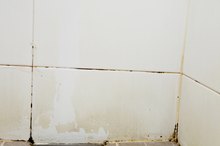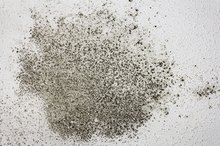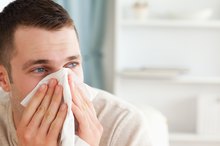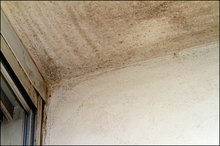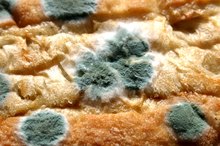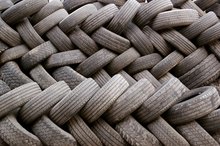What does fact checked mean?
At Healthfully, we strive to deliver objective content that is accurate and up-to-date. Our team periodically reviews articles in order to ensure content quality. The sources cited below consist of evidence from peer-reviewed journals, prominent medical organizations, academic associations, and government data.
The information contained on this site is for informational purposes only, and should not be used as a substitute for the advice of a professional health care provider. Please check with the appropriate physician regarding health questions and concerns. Although we strive to deliver accurate and up-to-date information, no guarantee to that effect is made.
What Are the Signs of Mold Sickness?
Mold is found throughout the environment, and grows best in moist environments. This type of fungus plays an important role in the decomposition of trees, leaves and other organic matter, and certain molds are used in the production of foods, such as cheese.
If you are experiencing serious medical symptoms, seek emergency treatment immediately.
However, touching or inhaling mold or mold spores — the seeds that help mold reproduce — can cause health effects. Respiratory symptoms are most common, occurring as a result of irritation, mold allergy or asthma. Also, people with compromised immune or respiratory systems are more likely to get a serious infection from mold.
Asthma and Allergy
Molds live everywhere, but when spores and particles get into the air — as with large or indoor mold growth, or when mold is disturbed — health effects can occur. Inhaling mold or mold spores can trigger allergic reactions in some people, and can cause or worsen asthma symptoms 1.
These health effects may be immediate or delayed. Most often, an allergic response leads to hay fever-like symptoms, such as runny nose, congestion, sneezing, itchy throat, irritated eyes, coughing or wheezing.
- Molds live everywhere, but when spores and particles get into the air — as with large or indoor mold growth, or when mold is disturbed — health effects can occur.
- Most often, an allergic response leads to hay fever-like symptoms, such as runny nose, congestion, sneezing, itchy throat, irritated eyes, coughing or wheezing.
Irritation
Side Effects of Mold Inhalation
Learn More
Mold can also irritate the eyes, nose, throat, skin and lungs — even in people who do not have allergies. Inhaling particles from large mold growth, such as:
- compost piles
- moldy mounds of hay
- or from a water-damaged home
- can lead to additional symptoms which include skin rash
- shortness of breath
- fever
Severe Health Effects
In some cases, mold exposure can lead to serious lung infections 3. However, these are more likely to occur in people who already have a respiratory disease, such as chronic emphysema or bronchitis, or in people undergoing cancer therapy or taking other medications that suppress the immune system. Antifungal medications are used to treat these infections.
Since dust mites and bacteria can also be found in moldy environments, more research is needed clarify the cause of these severe health complaints.
Read more about side effects of mold inhalation.
- In some cases, mold exposure can lead to serious lung infections.
- Since dust mites and bacteria can also be found in moldy environments, more research is needed clarify the cause of these severe health complaints.
Warnings
What Are the Effects of Breathing in Mold or Mildew?
Learn More
Control the growth of mold in your home by ventilating the bathroom, laundry and cooking areas, and by using a dehumidifier if needed to avoid too much indoor air moisture. Remove any indoor mold growth using soap and water, or with a bleach solution of no more than 1 cup of household bleach and 1 gallon of water, according to the CDC.
If your home has been damaged by flooding, or if your home has large amounts of mold growth, seek professional guidance for safe and effective cleanup. If you attribute any health problems symptoms to mold exposure, see your doctor.
Read more about mold indigestion treatments.
Reviewed by Kay Peck, MPH RD
- Control the growth of mold in your home by ventilating the bathroom, laundry and cooking areas, and by using a dehumidifier if needed to avoid too much indoor air moisture.
Related Articles
References
- U.S. Environmental Protection Agency: Molds and Health for Public Health Professionals
- Merck Manual: Overview of Fungal Infections
- U.S. Environmental Protection Agency: Indoor Air Facts No. 4 (Revised): Sick Building Syndrome
- Amirhosein Ghaffarianhoseini, Husam AlWaer, Hossein Omrany, Ali Ghaffarianhoseini, Chaham Alalouch, Derek Clements-Croome & John Tookey (2018) Sick building syndrome: are we doing enough?. Architectural Science Review,61:3, 99-121.
- American College of Allergy, Asthma & Immunology. Mold Allergy. Reviewed April 23, 2018.
- Centers for Disease Control and Prevention. Fungal Diseases. Reviewed May 6, 2019.
- Centers for Disease Control and Prevention. Mold. Basic Facts. Reviewed December 20, 2017
- Asthma and Allergy Foundation of America. Mold Allergy. Reviewed October 2015.
- Centers for Disease Control and Prevention. Molds in the Environment. Rreviewed December 20, 2017.
- Asthma and Allergy Foundation of America, Mold Allergy
- Centers for Disease Control and Prevention (CDC), Mold, Basic Facts
- Rudert A, Portnoy J.Mold allergy: is it real and what do we do about it?Expert Rev Clin Immunol. 2017 Aug;13(8):823-835. doi: 10.1080/1744666X.2017.1324298. Epub 2017 May 17.
Writer Bio
Based in California, Daniel Zisko has been a writer since 2008, penning articles for a variety of online publications. Before he started a writing career, he spent several years traveling and working as a hotel manager for several different hotel properties. Zisko holds a bachelor's degree in accounting from National University with a minor in biology.

